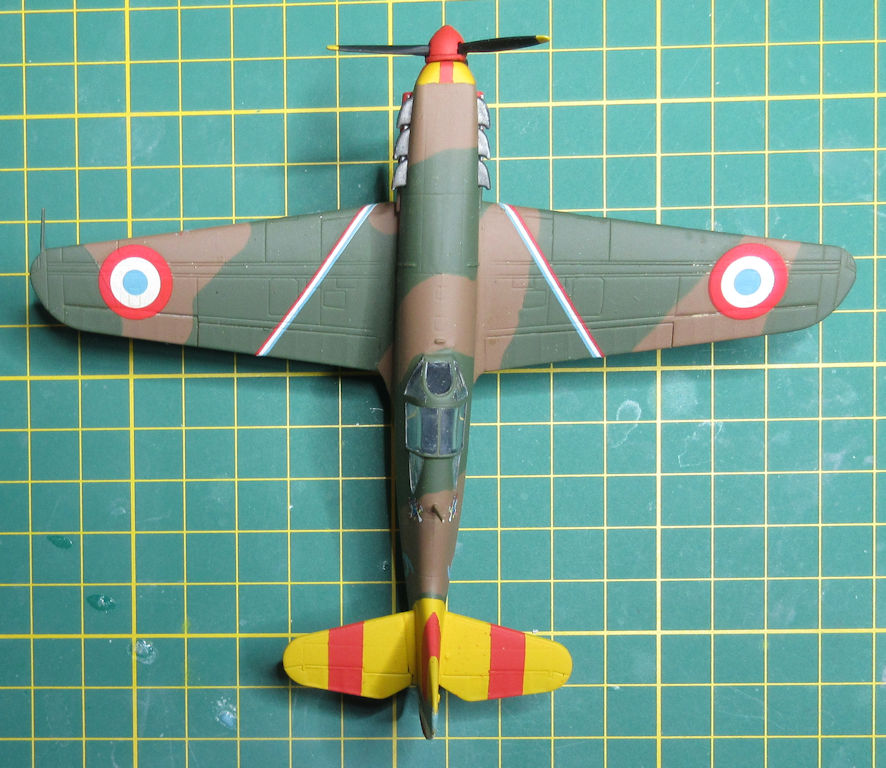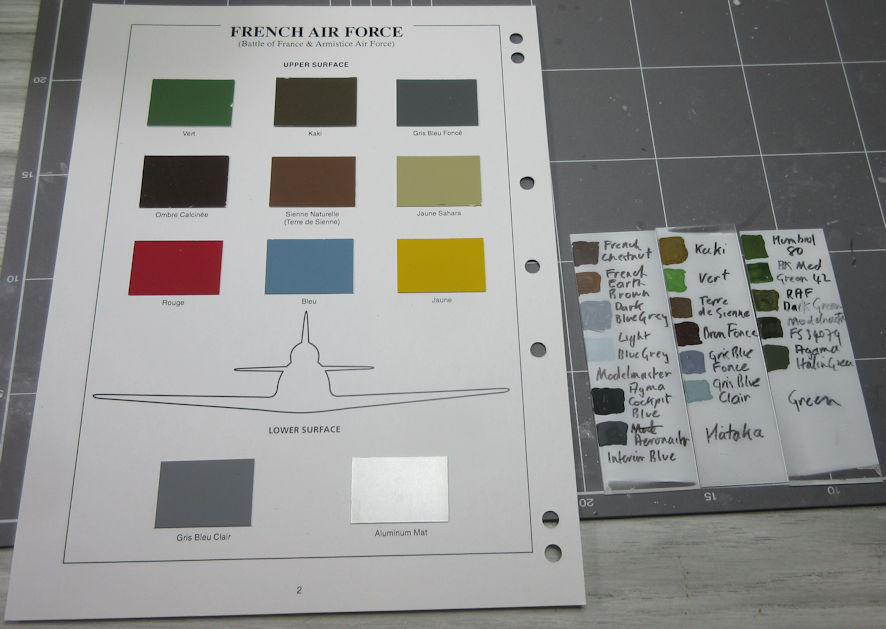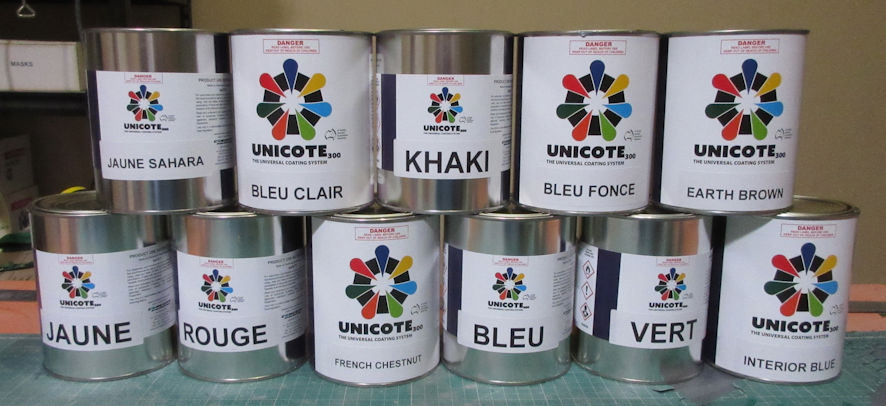(December 2019)
You might recall that earlier this year I made some Block 150 series fighters and ended up whinging about the colours of paint I was forced by circumstances to use. I’d bought the Hataka acrylic lacquer French World War II set of ‘authentic’ colours and was not happy. Since then this has been nagging on my mind and, a couple of weeks back, I decided that enough was enough and I had to do something about it.
This whole problem began about twenty years ago when I came to the realization that I was not going to make all the kits in my Treasure in my lifetime – even if it was a very long life – and that I should specialize in some category rather than just making models of whatever took my fancy. ‘I know’, I said, ‘I’ll make French aeroplanes.’ Then, in total ignorance of the history of French aviation or the efforts of M Palix and M Dujin to make kits of every obscure French aeroplane that ever existed, I added, ‘There can’t be too many of them’.
Not knowing much about French aeroplanes or what they looked like I went to the Perth Hobby Center – we were living in Perth at the time – and bought me some French aeroplanes and some ‘authentic’ paint in French colours to put on them. The result was a set of the three French fighters at the beginning of World War II, the Morane Saulnier 406, the Bloch 152 and the Dewoitine 520. (The fact that the French entered the war with three fighter types, four if you count the Caudron 714 and five if you count the Curtiss Hawk 75, should have warned me about what I was getting into!)
The kits were from Heller and just on the makeable side of basic, and the paint was from Aeromaster. It was a brand I’d never heard of – still being basically a Humbrol user at that stage – but it was the only source of ‘authentic’ French paint, so I gave it a go. It was okay and I was happy with the results. I followed the kit instructions because there was very little literature that I’d seen about French aeroplanes and, in the period before the interweb really got going, there was no other was of finding out what French aeroplanes at the beginning of World War II should look like.

When we arrived in Ballarat there was no Aeromaster paint with which to continue my excursion into French aviation, but the hobby shop in Sturt Street stocked Modelmaster paints which came in a huge rack and included around eight (as I recall) French ‘authentic’ colours. So I bought them and continued on with my growing interest in French aviation. When I compared these ‘authentic’ colours to those from Aeromaster bottles there were some striking differences, which puzzled me and led me into trying to find out more about what the right colours might be. However, at that stage, there was little reliable information so I learned what I could and pottered on. Generally speaking, I didn’t know whether the Aeromaster or the Modelmaster paints were the more ‘authentic’ but since I only had access to the Modelmaster enamels I resigned myself to a state of genteel ignorance. And when the shop owner decided to get out of the Modelmaster range I bought every bottle of French paint they had which, I assumed, would last me an eternity, so it didn’t matter much.

However, fifteen years later, when I started to run out of some colours, I discovered that it was impossible to buy any more Modelmaster paint in Australia. This was a serious problem because I’d come to rely on Modelaster enamels for just about all my military aviation and suddenly, on the whim of some importer, I was cut off from my supply of the good stuff. This led me into a brief and unfruitful exploration of the failings of acrylic paint (for me anyhow) and then the emerging range of acrylic lacquers which I already had some experience of from my use of the Tamiya rattle can range for airliner models. However, until recently, there has been nothing in that range that was suitable for French aeroplanes, until the Hataka set that I mentioned earlier. I ordered it from BNA with much expectation but was quite disappointed when it arrived and I tried it on those Bloch 150 series fighters.

Which led me to the point I was at a few weeks back. I felt the increasing and undeniable need to make some more French fighters but was unable to do so because I lacked the paint with which to decorate them. However, frustration leads to action.
But first, a quick lesson about French camouflage colours prior to and into World War II. (It took me years to figure this out and I’m giving it to you for free.) Before the Munich Crisis French aeroplanes were generally bare metal (perhaps with a protective transparent varnish) but after that they were painted Gris Bleu Clair (light blue grey) on the lower surfaces and Khaki on the upper surfaces. Towards the end of 1938 more colours were added to those that could be used; Vert (green), Terre de Sienne (earth brown) and Gris Bleu Fonce (dark blue grey). Gris Bleu Clair remained the under side colour but the upper side could have a base coat of Gris Bleu Fonce or Khaki with other colours painted over it in splodges in no particular pattern. (The result was that no two French aeroplanes were identical in camouflage patterns and all the lovely camouflage patterns one sees in books and on the interweb are largely inventions of the artist’s imagination.) There was another colour, Ombre Calcinee (Modelmaster called this Chestnut Brown) which was applied to aeroplanes like night bombers and another colour, Jaune Sahara (Sahara Yellow), which was used in place of one or more of the upper camouflage colours on aeroplanes operating south of the Mediterranean. The rudders of all French aeroplanes were painted in the stripes of Bleu (Blue), Blanche (White) and Rouge (Red) of equal spacing, and that’s about the only thing you can be certain of with French aeroplanes of this period.
After the Armistice the French or Vichy Air Force, which is apparently properly called the Armee de l’Air de l’Armistice, had to apply distinguishing markings which included white bars painted along fuselage sides and around roundels, also a 30 centimeter tricolour band and the empennage and fuselage rear (apart from the rudder) and nose had to be painted yellow, with red stripes that were added later. Some sources say that after the Armistice the French Air Force had matt aluminum undersides instead of Gris Bleu Clair, and others don’t. To add to the lack of uniformity, many of the shades used were mixed from existing paint stocks to suit the local environment in which French aircraft found themselves operating.
Confused? I still am. Most kits and decal sets these days go for a scheme of Gris Bleu Clair underside and Gris Bleu Fonce upperside with Vert and Terre de Sienne randomly over that, but who knows if they are right?
Nevertheless, there appear to be basic colours that were used and none of the three sets of paint I’d used, which claimed to be ‘authentic’, seemed to be that to me. In particular, I could see no point in paying good money for more sets of Hataka lacquers in which I would use only the Gris Bleu Fonce and Gris Bleu Clair and which didn’t include the Rouge or Blue colours which seem to be uniquely French and unavailable in other lacquers. These days there are several sources of possibly accurate information on authentic French colours and, of the ranges I’ve used, I prefer those from Modelmaster, and I would have kept using them had they been available. The only colour out of that range that I might have changed was their Vert, which seems a little bit too dark according to the sources I looked at.
Then I remembered that I’d faced this problem before. After they’d banned the carriage of enamel paints on aircraft and I’d been unable to import the Xtracolous range of airliner colours, I took my precious tins of Airbus and Boeing greys to Darby’s and they made for me colour matched lacquers which I am still happily using a decade or more later. Why not, I thought, do the same thing for French colours.


I gathered together all the existing ‘authentic’ French Modelaster and Hataka paint I had, colour chips, colour information with equivalents such as FS numbers, and models I’d previously made, and made up a list of what I consider to be ‘authentic’ French colours for the eleven basic colours I need. This took several hours and is not completely authentic because I made some slight variations to suit my preferences and the models I’ve already made. For example, the Terre de Sienne is almost identical to the Modelmaster shade and slightly less dark than the sources say it should while the Vert is lighter than the Modelmaster Vert but a little darker than what the original colour might have been.


Feeling still uncertain about my choices I crossed the Rubicon (a small tributary of it at least), went along to Darby’s with my list and collection of paints and colour patches, and ordered eleven one liter cans of paint colour matched to my specifications. They looked at me strangely but ‘the customer is the customer’. Colour matching cost $35 a go and after that the cost of the paint is almost negligible so I fought off the impulse to order two liter cans instead, just in case. (The paint thins to a ratio of 1 part paint to 1.5 parts thinner, giving me 2.5 liters of each, and I don’t expect to live long enough to use all that.) One thing I hadn’t thought of, ‘Matt or gloss?’ they asked. Gloss of course.
A couple of weeks later Darbys rang up, my paint was ready. For my Airbus and Boeing greys, and all the white I use, I thin the paint down, making a bit over half a liter of thinned paint, which I store in 100ml glass bottles that I buy off the internet. This paint is still thicker than most of the acrylic and lacquer paint you buy for modelling these days so it can be thinned again for airbrushing, but I find that it is an excellent paint for my 0.5 Badger Patriot running at about 20 psi and rarely needs more than one coat for good coverage. So, I took the afternoon off and sat thinning paint and putting it into bottles, about seven for each shade. That was until I ran out of thinner and bottles, and had to wait for more to arrive.

Eager to try out my new paint, I took a couple of old Hobby Boss 1/72 Dewoitine 520s out of my Treasure and stuck them together. They are very simple kits and just right for this trial use of my new paint. Painting took around a day’s work for the two models, a little longer for the one with the Jaune and Rouge Vichy stripes of shame. The paint flows beautifully out of my airbrush and dries almost instantly. Touching up using the unthinned paint is a breeze, unlike my experience with other acrylic and lacquer paints. The gloss sheen is just about right, negates the need for a gloss coat before applying the decals, would be ideal for gloss models, and takes a matting coat with no troubles. It’s all that I hoped it would be, though that light shade Vert is going to take a little getting used to.
